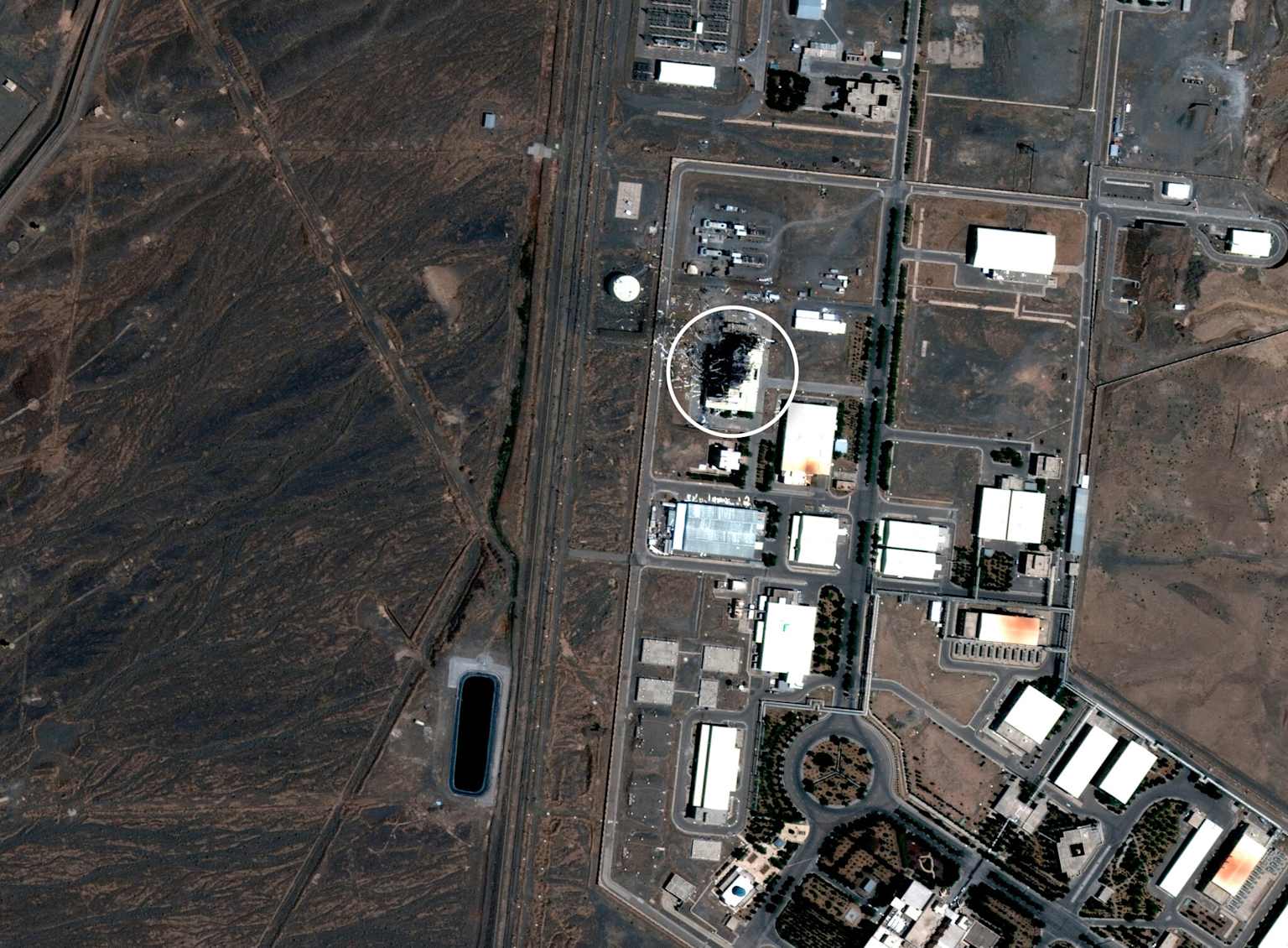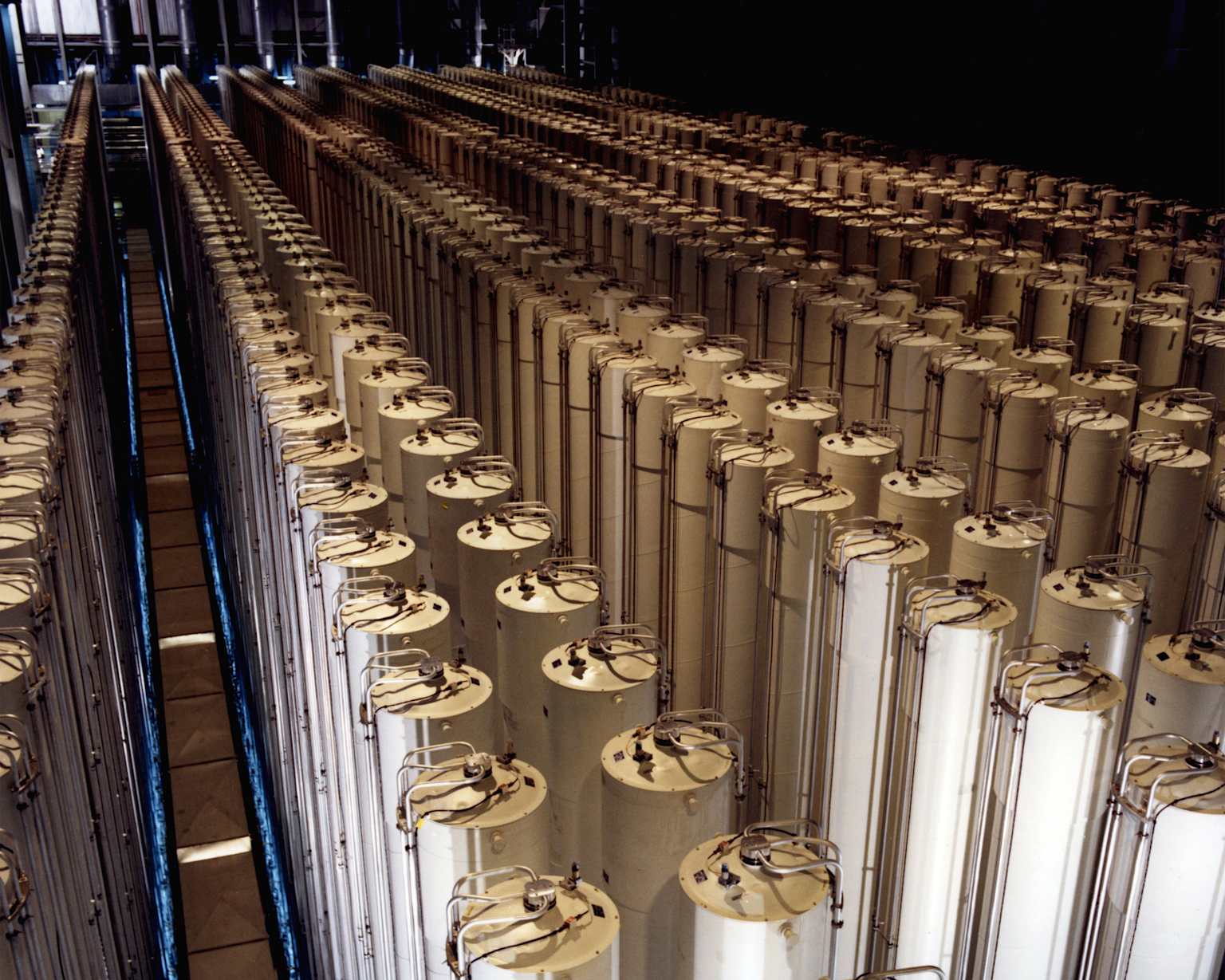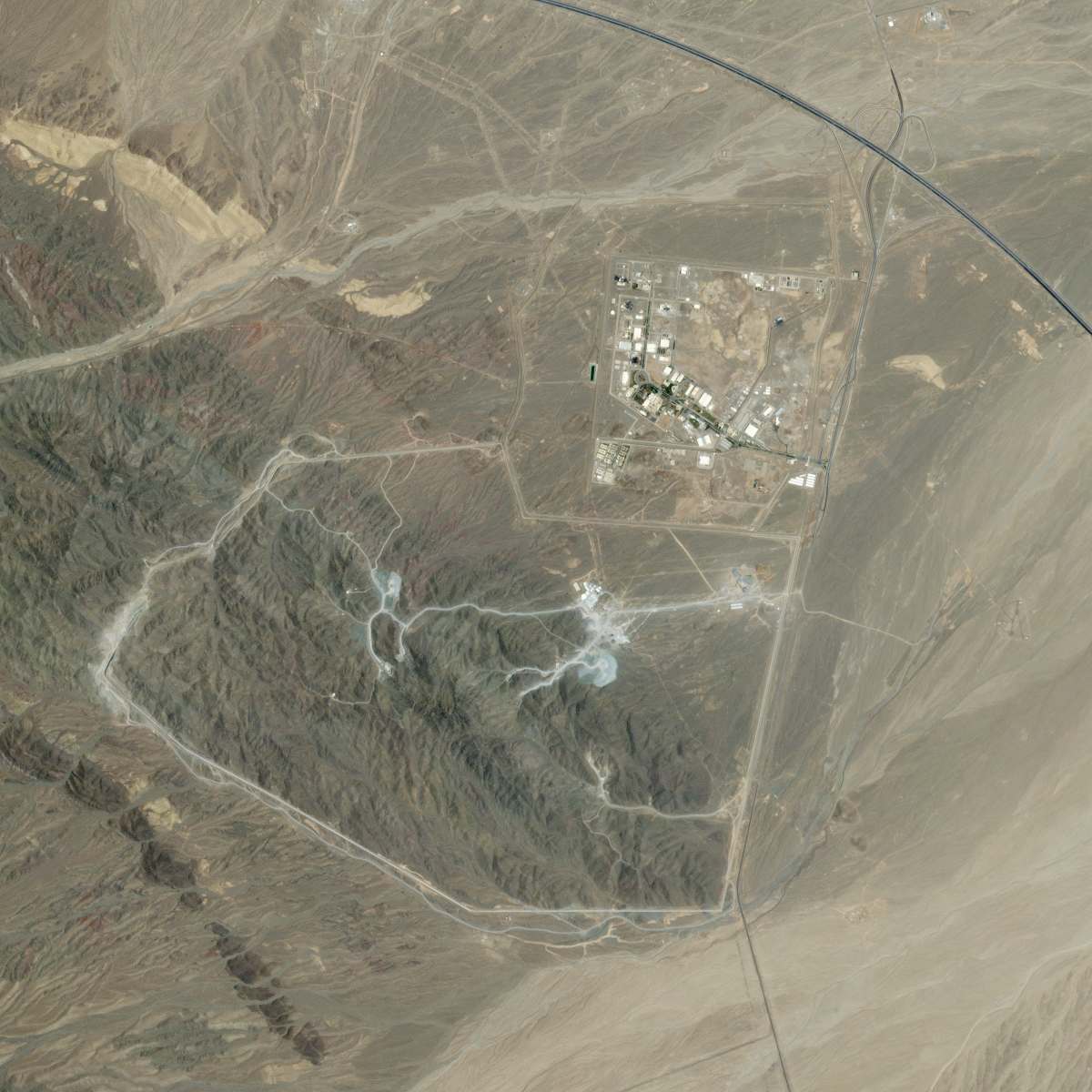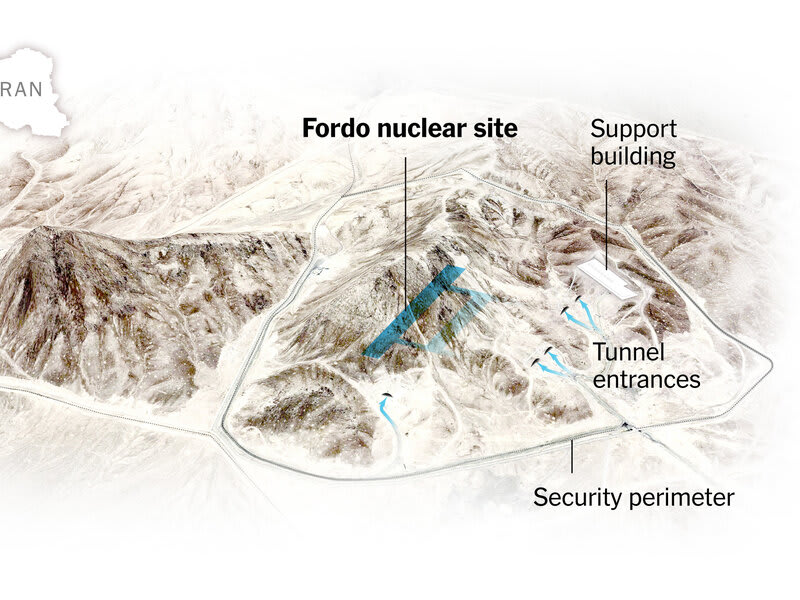Iran’s nuclear enrichment program has undergone a dramatic transformation with the deployment of advanced centrifuge technologies that significantly outperform the original IR-1 design 1. The introduction of the IR-2m and IR-4 centrifuges represents a quantum leap in Iran’s uranium enrichment capabilities, fundamentally altering the strategic calculus surrounding the country’s nuclear breakout timeline 23. These second-generation machines have become the backbone of Iran’s push toward greater enrichment capacity, enabling the production of higher quantities of enriched uranium with fewer machines than ever before 14.

Aerial view of Iran’s Natanz nuclear facility, showing its extensive infrastructure and a highlighted area of damage or construction.
Technical Superiority of Second-Generation Centrifuges
The IR-2m centrifuge stands as Iran’s most advanced production-ready enrichment technology, derived from Pakistan’s P-2 design obtained through the A.Q. Khan black market network in the 1990s 25. This machine utilizes a sophisticated rotor assembly composed of two carbon fiber rotors connected by a maraging steel bellows, allowing it to achieve significantly higher rotational speeds than its predecessor 67. The IR-2m’s rotor assembly measures approximately 60 centimeters in length with a 17-centimeter diameter, housed within a casing that extends between 155-162 centimeters in total height 6.

An industrial facility showing multiple rows of cylindrical vessels, indicative of a uranium enrichment cascade.
The IR-4 centrifuge represents a parallel development track, sharing the same P-2 heritage but incorporating an all-carbon fiber construction 26. The primary distinction between the IR-2m and IR-4 lies in their bellows technology, with the IR-4 employing carbon fiber bellows rather than the maraging steel used in the IR-2m 67. This design choice reflects Iran’s efforts to overcome material supply challenges while maintaining high performance standards 38.
Performance Metrics and Enrichment Capacity
Both the IR-2m and IR-4 centrifuges deliver approximately 4-5 separative work units (SWU) per year, representing a four to five-fold improvement over the IR-1’s output of roughly 0.8 SWU annually 29. When operating in production-scale cascades, the IR-2m achieves an estimated average output of 3.67 SWU per year, while the IR-4 produces approximately 3.3 SWU per year 103. These performance figures translate into dramatically reduced requirements for nuclear weapon fuel production, with only 1,200 advanced centrifuges needed to produce weapons-grade uranium compared to 3,000 IR-1 machines 511.

A cascade of centrifuges arranged for uranium enrichment within a nuclear facility.
The enhanced efficiency of these machines has profound implications for Iran’s breakout capability. A facility equipped with 3,000 IR-2m centrifuges could theoretically produce the uranium for one nuclear weapon in approximately four months, compared to over a year using equivalent numbers of IR-1 machines 127. This acceleration in production capacity has become a central concern for international observers monitoring Iran’s nuclear activities 13.
Deployment and Current Status
Iran’s advanced centrifuge deployment has accelerated dramatically since 2018, following the U.S. withdrawal from the Joint Comprehensive Plan of Action (JCPOA) 313. As of early 2025, Iran operates approximately 1,500 IR-2m centrifuges and 500 IR-4 centrifuges at the Natanz Fuel Enrichment Plant, alongside hundreds more at the pilot facility 1312. The Fordow Fuel Enrichment Plant, buried deep underground near Qom, also houses advanced centrifuge cascades, though in smaller numbers due to space constraints 1314.

An aerial view of the Natanz nuclear facility, a key site for Iran’s uranium enrichment program.
Recent International Atomic Energy Agency (IAEA) reports indicate that Iran has plans to install an additional 18 cascades of IR-4 centrifuges at Natanz, each containing 166 machines 1516. This expansion would significantly increase Iran’s enrichment capacity and further reduce theoretical breakout timelines 1512. The shift toward IR-2m and IR-4 deployment reflects Iran’s strategic decision to prioritize efficiency over quantity in its centrifuge program 316.
Material Challenges and Supply Chain Considerations
The production of IR-2m and IR-4 centrifuges requires sophisticated materials, particularly high-quality carbon fiber for rotor construction 86. International sanctions have complicated Iran’s access to these materials, forcing the country to develop domestic production capabilities or rely on clandestine procurement networks 38. Despite these challenges, Iran has demonstrated remarkable resilience in maintaining centrifuge production, suggesting the existence of robust supply chains for critical components 317.

Aerial diagram of Iran’s Fordow nuclear site, highlighting its underground location within a mountain.
The carbon fiber requirements for these centrifuges represent a particular vulnerability, as this material demands precise manufacturing specifications to withstand the extreme rotational forces involved in uranium enrichment 618. Iran’s ability to consistently produce functional IR-2m and IR-4 centrifuges indicates either successful domestic carbon fiber production or continued access to international suppliers despite sanctions 38.
Strategic Implications and International Response
The proliferation of IR-2m and IR-4 centrifuges has fundamentally altered the international community’s approach to Iran’s nuclear program 119. The reduced breakout timeline created by these advanced machines has prompted renewed diplomatic efforts and, in some cases, consideration of military options 2021. The underground placement of many of these centrifuges at facilities like Fordow complicates potential military responses, as conventional weapons cannot effectively target deeply buried installations 2022.
International sanctions regimes have evolved to specifically target the materials and technologies required for advanced centrifuge production 1723. However, Iran’s demonstrated ability to continue deploying these machines suggests that sanctions alone may be insufficient to halt the program’s advancement 317. The knowledge and expertise gained through IR-2m and IR-4 development represents an irreversible technological achievement that cannot be undone through diplomatic agreements 13.
Future Trajectory and Developments
Iran’s centrifuge program shows no signs of slowing, with plans for further expansion of IR-2m and IR-4 deployment alongside development of even more advanced models 1516. The construction of new underground facilities and expansion of existing sites indicates Iran’s commitment to long-term enrichment capability enhancement 2421. Recent IAEA reports suggest Iran may be preparing to activate additional enrichment sites, potentially increasing the geographic distribution of its advanced centrifuge inventory 2115.
The strategic implications of Iran’s advanced centrifuge program extend beyond immediate breakout calculations to encompass broader questions of regional stability and nuclear proliferation 117. As IR-2m and IR-4 centrifuges become the dominant technology in Iran’s enrichment infrastructure, the international community faces increasingly complex challenges in managing the nuclear dimensions of Iranian policy 119. The technological gains represented by these machines cannot be reversed, ensuring that any future diplomatic resolution must account for Iran’s enhanced enrichment capabilities 13.
Footnotes
-
https://www.iranwatch.org/our-publications/weapon-program-background-report/irans-centrifuges-models-status ↩ ↩2 ↩3 ↩4 ↩5 ↩6 ↩7 ↩8
-
https://iranprimer.usip.org/blog/2021/nov/22/explainer-controversy-over-iran’s-centrifuges ↩ ↩2 ↩3 ↩4
-
https://isis-online.org/isis-reports/detail/september-2022-highlights-of-survey-of-irans-advanced-centrifuges/8 ↩ ↩2 ↩3 ↩4 ↩5 ↩6 ↩7 ↩8 ↩9 ↩10 ↩11 ↩12
-
https://www.nti.org/analysis/articles/iranian-centrifuge-model-collection/ ↩
-
https://www.isis-online.org/publications/iran/ISIS_Iran_P2_7Feb2008.pdf ↩ ↩2
-
https://www.iranwatch.org/our-publications/articles-reports/beyond-ir-1-irans-advanced-centrifuges-their-lasting-implications ↩ ↩2 ↩3 ↩4 ↩5 ↩6
-
https://www.washingtoninstitute.org/policy-analysis/iranian-nuclear-breakout-what-it-and-how-calculate-it ↩ ↩2 ↩3
-
https://www.armscontrol.org/act/2013-02/iran-installs-advanced-centrifuges ↩ ↩2 ↩3 ↩4
-
https://www.armscontrol.org/act/2014-06/features/agreeing-limits-irans-centrifuge-program-two-stage-strategy ↩
-
https://isis-online.org/uploads/isis-reports/documents/A_Comprehensive_Survey_of_Irans_Advanced_Centrifuges_December_2021.pdf ↩
-
https://www.iranwatch.org/our-publications/articles-reports/irans-nuclear-timetable-weapon-potential ↩ ↩2 ↩3
-
https://www.iranwatch.org/our-publications/weapon-program-background-report/history-irans-nuclear-program ↩ ↩2 ↩3
-
https://www.aljazeera.com/news/2025/6/19/what-is-irans-fordow-nuclear-facility-and-could-us-weapons-destroy-it ↩
-
https://www.aljazeera.com/news/2024/11/29/iran-plans-to-install-6000-centrifuges-to-enrich-uranium-iaea-says ↩ ↩2 ↩3 ↩4
-
https://isis-online.org/isis-reports/detail/updated-highlights-of-survey-of-irans-advanced-centrifuges-March2023 ↩ ↩2 ↩3
-
https://en.wikipedia.org/wiki/International_sanctions_against_Iran ↩ ↩2 ↩3 ↩4
-
https://tools.thermofisher.com/content/sfs/brochures/D21232~.pdf ↩
-
https://isis-online.org/isis-reports/detail/iranian-breakout-timelines-under-jcpoa-type-limits/ ↩ ↩2
-
https://www.csis.org/analysis/options-targeting-irans-fordow-nuclear-facility ↩ ↩2
-
https://apnews.com/article/iran-nuclear-iaea-sanctions-728b811da537abe942682e13a82ff8bd ↩ ↩2 ↩3
-
https://www.csis.org/analysis/three-things-will-determine-irans-nuclear-future-fordow-just-one-them ↩